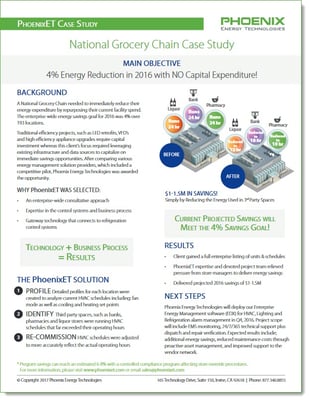Share this
What Grocery Stores Are Doing About Cold Air Spillover
by Mandi McDonald on Feb 17, 2020

Major retailers across the U.S. are trialing or rolling out doors or covers on their cold cases to combat cold air spillover from open grocery coolers. The energy-saving opportunity seems obvious, however, many stores and chains hesitate from retrofitting or upgrading chillers to closed cases.
Why Consider Doors on Grocery Coolers?
Supermarkets operate within extremely thin profit margins. The average margin is somewhere in the 1-3% range. A typical individual grocery store spends between $200K-$240K on energy annually. A 5% reduction in energy spend would equal an $11K annual savings - now multiply that across the chain.
A 5% savings in energy would have about the same effect on a store’s bottom line as a $1.1M increase in annual sales. This is because to earn $11K in profit, sales has to go up by $1.1M.

It is a lot easier for a store to increase profits by reducing energy consumption than it is to try and increase sales.
And once costs associated with investing in upgrading or retrofitting to closed-door coolers are recouped, the proactive nature of saving on energy helps groceries achieve increased overall profit.
Energy Savings With Cooler Doors
The EPA says industry studies show energy savings on closed-door grocery coolers at around 30%. One particular study shows that replacing 120 feet of open cooler cases with closed door cases brought down a store's energy spend from $19,078 to $5,533 - a 71% savings.
And it is not only energy dollars that can be saved. There are other ways to save money with closed doors. Cutting food spoilage, increasing customer comfort, avoiding overworking refrigeration units, and reducing carbon footprints are all additional benefits.
Other savings include:
- Coolers with doors maintain more regulated temperatures, which add to food storage life.
- Keeping cool air inside units prevents shopping aisle temperatures from becoming too cold, which negatively affects customer behavior.
- Refrigeration units work much harder during winter months to maintain cold temperatures when grocery store heating is on. This adds to wear on unit components and leads to more costly maintenance calls.
- Reducing energy waste brings down carbon footprints and enables grocery stores to have an environmentally-friendly reputation, which is particularly valuable among millennial shoppers.
Why The Hesitation On Grocery Cooler Doors?
Supermarket managements hesitate because they are concerned that it may impact customer behavior, which could hinder sales. Many grocery stores and chains believe that the impulse buying behavior, which they work hard to trigger in customers, will be curtailed when customers have to open a cooler door, particularly if their arms are full of products.
Some studies indicate this to be true. One study shows that while staple items like milk, cheese, and yogurt do not experience a dip in sales when cooler doors are added, non-staples, like snacks, small-goods, and entertainment foods, do take a hit.
Be that as it may, the variety of saving opportunities possible should be weighed against the percentage of potential lost sales. The grocery chain Supervalu, for example, stated they would risk a drop in sales of 2% in installing cooler doors as they identified overall savings that would offset the potential loss.
Another hesitation to use cooler doors is that consumers who like to read product labels would be less likely to do so if the product was behind a door. While studies show doors can impact label reading on mostly newer products and brands hitting store shelves, there are avenues a store can take to mitigate the inconvenience.
For example, customers whose arms are full of products that may want to read a product label behind a cooler door, might still be inclined to do so if the store had a stand of shopping baskets in the area. Small tactics such as placing baskets stands near closed cases may encourage a customer to grab a basket to free up their hands so they can check out a label.
Commercial Ads on Cooler Doors
What if there was a way to make money on the cooler doors themselves? An idea being trialed by a number of marketing firms and grocery stores is the use of digital cooler (and freezer) door ads.
Some trials are seeing a 13% increase in traffic to cooler doors with ads and a 4% increase in sales on product behind those doors. Walgreens and a company called Cooler Screens are undergoing a trial of digital cooler doors. Cooler Screens claims to share ad revenue on a sliding scale between 25-75% with participating retailers.
Overall Benefits of Cooler Doors
The benefits of saving energy with cooler doors are obvious, although they do need to be weighed with other factors.
Benefits of closed cases include:
- Balanced temperatures
- Fewer defrost cycles
- Longer lasting product
- Warmer aisles for customer comfort
- Attractively cold drinks and product
- Increased positive reputation for reducing carbon emissions
- Potential offsets with energy rebates from local utilities
Issues to take into consideration when installing or upgrading to cooler doors:
- Rack load changes on retrofitted cases
- Impact on heating and cooling loads - After doors are installed, perform a recalibration as HVAC systems may require adjustments.
- Aisle widths - Are doors practical in the store?
- Consider adding aisle occupancy sensors for segments of doors in conjunction with installing the doors for added savings potential.
- The shape of existing cases - Can they handle a retrofit? Are they too old/worn out to justify the cost of retrofit?

We have been providing smart building solutions that integrate with building systems for grocery, retail, theaters, and other sectors with energy-saving goals for over 15 years.
To see how we can help grocery stores save energy, download our case study on how we helped a national chain save 4% in energy over 193 locations (a million dollars+ annual savings).
Energy Saving Case Studies
Healthcare Study - Full Visibility With Minimal Expenditure
National Department Store Saves $10M In Energy Savings
Retailer Gains Enterprise-Wide Visibility
Spotlight on Energy Savings: A National Movie Chain Study
Share this
- Facilities Management (90)
- Energy Management (68)
- Company News (49)
- Smart Buildings (37)
- Retail (36)
- Building Management (24)
- Building Automation Systems (21)
- Energy Demand Management (19)
- Sustainability (19)
- EEI (15)
- Adaptive Energy Management (14)
- Grocery (14)
- demand response (13)
- Artificial Intelligence (12)
- Data Integration and Visibility (10)
- HVAC IQ (9)
- COVID-19 (8)
- Customer Spotlight (8)
- Carbon Management (7)
- Setpoints and Temperatures (7)
- Equipment Maintenance (6)
- Operational Efficiency (6)
- Ask Ron (5)
- Asset Manager (5)
- Finance and Procurement (5)
- IoT and Digital Transformation (5)
- Refrigeration Optimization (5)
- Awards (4)
- Comfort (4)
- Energy & Store Development (4)
- Safety and Compliance (4)
- Energy Management System (3)
- Premium Services (3)
- ConnexFM (2)
- Customer Service (2)
- Demand Charge Management (2)
- HVAC Vendor Management (2)
- Lifecycle Asset Management (2)
- Load Shedding (2)
- Refrigeration IQ (2)
- Technician View (2)
- Analytics (1)
- Automated Demand Response (1)
- Data (1)
- Data Integration and Visualization (1)
- EMS (1)
- Knowledge Center (1)
- OSHA (1)
- asset management (1)
- October 2025 (2)
- September 2025 (1)
- August 2025 (3)
- July 2025 (1)
- June 2025 (1)
- May 2025 (2)
- March 2025 (2)
- February 2025 (1)
- January 2025 (2)
- December 2024 (2)
- October 2024 (1)
- September 2024 (1)
- August 2024 (2)
- June 2024 (2)
- April 2024 (2)
- March 2024 (2)
- January 2024 (1)
- December 2023 (1)
- October 2023 (2)
- September 2023 (2)
- August 2023 (2)
- July 2023 (1)
- May 2023 (2)
- April 2023 (2)
- March 2023 (3)
- February 2023 (1)
- January 2023 (1)
- December 2022 (1)
- November 2022 (2)
- October 2022 (2)
- September 2022 (1)
- May 2022 (2)
- April 2022 (1)
- March 2022 (3)
- February 2022 (2)
- January 2022 (4)
- December 2021 (2)
- November 2021 (3)
- October 2021 (1)
- September 2021 (3)
- August 2021 (4)
- July 2021 (1)
- June 2021 (2)
- May 2021 (1)
- January 2021 (2)
- December 2020 (2)
- November 2020 (2)
- October 2020 (3)
- September 2020 (4)
- August 2020 (3)
- July 2020 (2)
- June 2020 (3)
- May 2020 (3)
- April 2020 (5)
- March 2020 (5)
- February 2020 (4)
- January 2020 (4)
- December 2019 (4)
- November 2019 (3)
- October 2019 (4)
- September 2019 (5)
- August 2019 (4)
- July 2019 (4)
- May 2019 (2)
- April 2019 (3)
- February 2019 (1)
- December 2018 (1)
- November 2018 (1)
- October 2018 (3)
- September 2018 (3)
- August 2018 (3)
- July 2018 (3)
- June 2018 (3)
- May 2018 (1)
- June 2015 (1)
- March 2013 (1)
- January 2013 (1)
- December 2011 (1)
- October 2011 (1)
- September 2011 (1)


